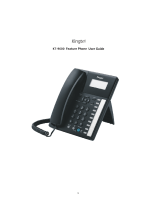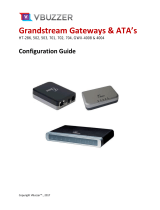
Grandstream Networks, Inc. HT-502 User Manual Page 2 of 35
Firmware 1.0.0.39 Last Updated: 03/2007
TABLE OF CONTENTS
HT–502 User Manual
WELCOME....................................................................................................................................................4
S
AFETY COMPLIANCES.................................................................................................................................4
W
ARRANTY..................................................................................................................................................4
CONFIGURE YOUR HT–502 .......................................................................................................................5
E
QUIPMENT PACKAGING...............................................................................................................................5
C
ONNECT YOUR ATA ..................................................................................................................................5
C
ONFIGURE YOUR ATA ...............................................................................................................................6
Five easy steps to Configure the HT–502.............................................................................................6
PRODUCT OVERVIEW................................................................................................................................7
K
EY FEATURES............................................................................................................................................7
BASIC OPERATIONS..................................................................................................................................9
B
ECOMING FAMILIAR WITH THE VOICE PROMPTS...........................................................................................9
P
LACING A PHONE CALL.............................................................................................................................10
Phone or Extension Numbers..............................................................................................................10
Direct IP Calls......................................................................................................................................11
C
ALL HOLD................................................................................................................................................11
C
ALL WAITING ...........................................................................................................................................11
C
ALL TRANSFER ........................................................................................................................................12
3-W
AY CONFERENCING .............................................................................................................................12
CALL FEATURES......................................................................................................................................13
S
ENDING AND RECEIVING FAX....................................................................................................................14
CONFIGURATION GUIDE .........................................................................................................................14
C
ONFIGURING THE HT–502 VIA VOICE PROMPTS.......................................................................................14
DHCP Mode.........................................................................................................................................14
STATIC IP Mode..................................................................................................................................14
Firmware Server IP Address................................................................................................................14
Configuration Server IP Address.........................................................................................................14
Upgrade Protocol.................................................................................................................................14
Firmware Upgrade Mode.....................................................................................................................14
WAN Port Web Access........................................................................................................................14
C
ONFIGURING THE HT–502 USING THE WEB BROWSER.............................................................................15
Access the Web Configuration Menu ..................................................................................................15
E
ND USER CONFIGURATION .......................................................................................................................16
I
MPORTANT SETTINGS................................................................................................................................16
NAT Settings........................................................................................................................................16
DTMF Methods....................................................................................................................................17
Preferred VOCODER (Codec).............................................................................................................17
A
DVANCED USER CONFIGURATION .............................................................................................................21
S
AVING THE CONFIGURATION CHANGES .....................................................................................................27
R
EBOOTING THE HT–502 FROM REMOTE ...................................................................................................27
C
ONFIGURATION THROUGH A CENTRAL SERVER..........................................................................................28
GAPS
– GRANDSTREAM AUTOMATED PROVISIONING SYSTEM.....................................................................28
SOFTWARE UPGRADE.............................................................................................................................29
F
IRMWARE UPGRADE THROUGH TFTP/HTTP.............................................................................................29
C
ONFIGURATION FILE DOWNLOAD ..............................................................................................................30
F
IRMWARE AND CONFIGURATION FILE PREFIX AND POSTFIX ........................................................................30
M
ANAGING FIRMWARE AND CONFIGURATION FILE DOWNLOAD .....................................................................30
RESTORE FACTORY DEFAULT SETTING..............................................................................................31
R
ESET VIA THE RESET BUTTON..................................................................................................................31
R
ESET VIA IVR..........................................................................................................................................31
GLOSSARY OF TERMS ............................................................................................................................32





















